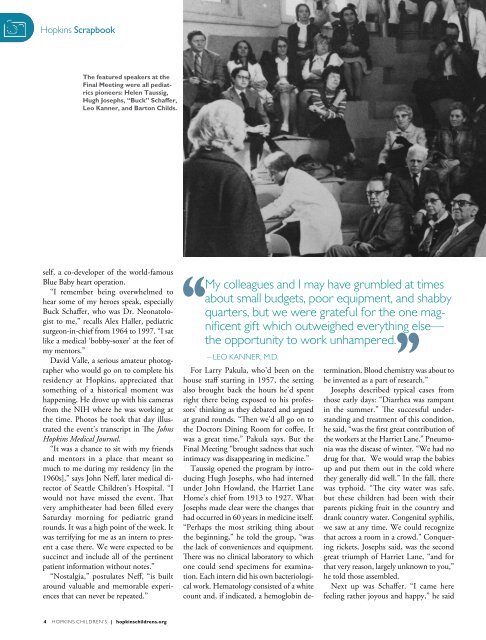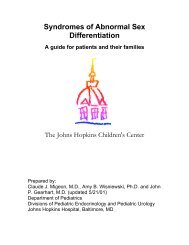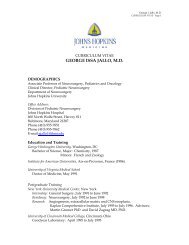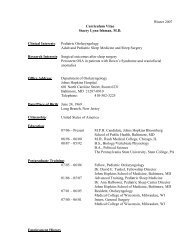Meals “at Your request” - Johns Hopkins Children's Center
Meals “at Your request” - Johns Hopkins Children's Center
Meals “at Your request” - Johns Hopkins Children's Center
You also want an ePaper? Increase the reach of your titles
YUMPU automatically turns print PDFs into web optimized ePapers that Google loves.
<strong>Hopkins</strong> Scrapbook<br />
the featured speakers at the<br />
Final Meeting were all pediatrics<br />
pioneers: Helen taussig,<br />
Hugh Josephs, “Buck” schaffer,<br />
Leo Kanner, and Barton Childs.<br />
self, a co-developer of the world-famous<br />
Blue Baby heart operation.<br />
“I remember being overwhelmed to<br />
hear some of my heroes speak, especially<br />
Buck Schaffer, who was Dr. Neonatologist<br />
to me,” recalls Alex Haller, pediatric<br />
surgeon-in-chief from 1964 to 1997. “I sat<br />
like a medical ‘bobby-soxer’ at the feet of<br />
my mentors.”<br />
David Valle, a serious amateur photographer<br />
who would go on to complete his<br />
residency at <strong>Hopkins</strong>, appreciated that<br />
something of a historical moment was<br />
happening. He drove up with his cameras<br />
from the NIH where he was working at<br />
the time. Photos he took that day illustrated<br />
the event’s transcript in The <strong>Johns</strong><br />
<strong>Hopkins</strong> Medical Journal.<br />
“It was a chance to sit with my friends<br />
and mentors in a place that meant so<br />
much to me during my residency [in the<br />
1960s],” says John Neff, later medical director<br />
of Seattle Children’s Hospital. “I<br />
would not have missed the event. That<br />
very amphitheater had been filled every<br />
Saturday morning for pediatric grand<br />
rounds. It was a high point of the week. It<br />
was terrifying for me as an intern to present<br />
a case there. We were expected to be<br />
succinct and include all of the pertinent<br />
patient information without notes.”<br />
“Nostalgia,” postulates Neff, “is built<br />
around valuable and memorable experiences<br />
that can never be repeated.”<br />
4 HOPKINS CHILDreN’S | hopkinschildrens.org<br />
my colleagues and I may have grumbled at times<br />
about small budgets, poor equipment, and shabby<br />
quarters, but we were grateful for the one magnificent<br />
gift which outweighed everything else—<br />
the opportunity to work unhampered.<br />
– LeO KANNer, m.D.<br />
For Larry Pakula, who’d been on the<br />
house staff starting in 1957, the setting<br />
also brought back the hours he’d spent<br />
right there being exposed to his professors’<br />
thinking as they debated and argued<br />
at grand rounds. “Then we’d all go on to<br />
the Doctors Dining Room for coffee. It<br />
was a great time,” Pakula says. But the<br />
Final Meeting “brought sadness that such<br />
intimacy was disappearing in medicine.”<br />
Taussig opened the program by introducing<br />
Hugh Josephs, who had interned<br />
under John Howland, the Harriet Lane<br />
Home’s chief from 1913 to 1927. What<br />
Josephs made clear were the changes that<br />
had occurred in 60 years in medicine itself.<br />
“Perhaps the most striking thing about<br />
the beginning,” he told the group, “was<br />
the lack of conveniences and equipment.<br />
There was no clinical laboratory to which<br />
one could send specimens for examination.<br />
Each intern did his own bacteriological<br />
work. Hematology consisted of a white<br />
count and, if indicated, a hemoglobin de-<br />
termination. Blood chemistry was about to<br />
be invented as a part of research.”<br />
Josephs described typical cases from<br />
those early days: “Diarrhea was rampant<br />
in the summer.” The successful understanding<br />
and treatment of this condition,<br />
he said, “was the first great contribution of<br />
the workers at the Harriet Lane.” Pneumonia<br />
was the disease of winter. “We had no<br />
drug for that. We would wrap the babies<br />
up and put them out in the cold where<br />
they generally did well.” In the fall, there<br />
was typhoid. “The city water was safe,<br />
but these children had been with their<br />
parents picking fruit in the country and<br />
drank country water. Congenital syphilis,<br />
we saw at any time. We could recognize<br />
that across a room in a crowd.” Conquering<br />
rickets, Josephs said, was the second<br />
great triumph of Harriet Lane, “and for<br />
that very reason, largely unknown to you,”<br />
he told those assembled.<br />
Next up was Schaffer. “I came here<br />
feeling rather joyous and happy,” he said





